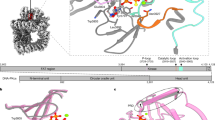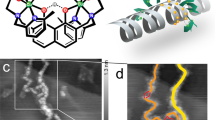Abstract
DFF40/CAD, the major apoptotic nuclease, is specific for double-stranded DNA. However, RNA and single-stranded DNA, though not substrates for the enzyme, compete with double-stranded DNA and inhibit its cleavage by the nuclease. In addition, other anionic polymers, like poly-glutamic acid and heparin also inhibit DFF40/CAD, the latter one being highly effective at nanomolar concentrations. The inhibitory poly-anions bind to the nuclease and impair its ability to bind double-stranded DNA. We propose that such poly-anions bind to the positively charged surface formed by α4 helices of the DFF40/CAD homodimer. This surface has been proposed recently to bind to either the major groove of DNA or poly (ADP-ribose), another inhibitor of the nuclease.
Similar content being viewed by others
References
Widlak P, Garrard WT (2005) Discovery, regulation, and action of the major apoptotic nucleases DFF40/CAD and endonuclease G. J Cell Biochem 94:1078–1087
Liu X, Zou H, Slaughter C, Wang X (1997) DFF, a heterodimeric protein that functions downstream of caspase-3 to trigger DNA fragmentation during apoptosis. Cell 89:175–184
Liu X, Li P, Widlak P, Zou H, Luo X, Garrard WT, Wang X (1998) DFF40 induces DNA fragmentation and chromatin condensation during apoptosis. Proc Natl Acad Sci USA 95:8461–8466
Enari M, Sakahira H, Yokoyama H, Okawa K, Iwamatsu A, Nagata S (1998) A caspase-activated DNase that degrades DNA during apoptosis, and its inhibitor ICAD. Nature 391:43–50
Halenbeck R, MacDonald H, Roulston A, Chen TT, Conroy L, Williams LT (1998) CPAN, a human nuclease regulated by the caspase-sensitive inhibitor DFF45. Curr Biol 8:537–540
Lechardeur D, Dougaparsad S, Nemes C, Lukacs GL (2005) Oligomerization state of the DNA fragmentation factor (DFF) in normal and apoptotic cells. J Biol Chem 280:40216–40225
Woo E-J, Kim J-G, Kim M-S, Han W-D, Shin S, Robinson H, Park S-J, Oh B-H (2004) Structural mechanism for inactivation and activation of CAD/DFF40 in the apoptotic pathway. Mol Cell 14:531–539
Liu X, Zou H, Widlak P, Garrard WT, Wang X (1999) Activation of the apoptotic endonuclease DFF40 (caspase-activated DNase or nuclease). Oligomerization and direct interactions with histone H1. J Biol Chem 274:13836–13840
Widlak P, Lanuszewska J, Cary RB, Garrard WT (2003) Subunit structures and stoichiometries of human DFF proteins before and after induction of apoptosis. J Biol Chem 278:26915–26922.
Widlak P, Kalinowska M, Parseghian MH, Lu X, Hansen JC, Garrard WT (2005) The histone H1 C-terminal domain binds to the apoptotic nuclease, DNA Fragmentation Factor (DFF40/CAD) and stimulates DNA cleavage. Biochemistry 44:7871–7878
Ahn J-Y, Liu X, Cheng D, Peng J, Chan P-K, Wade PA, Ye K (2005) Nucleophosmin/B23, a nuclear PI(3,4,5)P3 receptor, mediates the antiapoptotic actions of NGF by inhibiting CAD. Mol Cell 18:435–445
Cho S-G, Kim JW, Lee YH, Hwang HS, Kim M-S, Ryoo K, Kim MJ, Noh KT, Kim EK, Cho J-H, Yoon KW, Cho E-G, Park H-S, Chi SW, Lee M-J, Kang SS, Ichijo H, Choi E-J (2003) Identification of a novel antiapoptotic protein that antagonizes ASK1 and CAD activities. J Cell Biol 163:71–81
Widlak P, Li P, Wang X, Garrard WT (2000) Cleavage preferences of the apoptotic endonuclease DFF40 (Caspase-activated DNase or Nuclease) on naked DNA and chromatin substrates. J Biol Chem 275:8226–8232
West JD, Ji C, Marnett LJ (2005). Modulation of DNA fragmentation factor 40 nuclease activity by poly(ADP-ribose) polymerase-1. J Biol Chem 280:15141–15147
Reh S, Korn C, Gimadutdinow O, Meiss G (2005) Structural basis for stable DNA-complex formation by the caspase-activated DNase. J Biol Chem 280:41707–41715
Linhardt RJ (2004) Heparin-induced cancer cell death. Chem Biol 11:420–422
Bose P, Black S, Kadyrov M, Weissenborn U, Neulen J, Regan L, Huppertz B (2005) Heparin and aspirin attenuate placental apoptosis in vitro: Implications for early pregnancy failure. Am J Obstet Gynecol 192:23–30
Yagmurdur MC, Turk E, Moray G, Can F, Demirbilek M, Haberal N, Karabay G, Karakayali H, Haberal M (2005) Effects of heparin on bacterial translocation and gut epithelial apoptosis after burn injury in the rat: Dose-dependent inhibition of the complement cascade. Burns 31:603–609
Kalinowska M, Garncarz W, Pietrowska M, Garrard WT, Widlak P (2005) Regulation of the human apoptotic DNase/RNase EndoG; involvement of Hsp70 and ATP. Apoptosis 10:821–830
Author information
Authors and Affiliations
Corresponding author
Rights and permissions
About this article
Cite this article
Widlak, P., Garrard, W.T. The apoptotic endonuclease DFF40/CAD is inhibited by RNA, heparin and other polyanions. Apoptosis 11, 1331–1337 (2006). https://doi.org/10.1007/s10495-006-6983-0
Published:
Issue Date:
DOI: https://doi.org/10.1007/s10495-006-6983-0




